Francisca O. Oladipo , Christogonus C. Madu , Christopher C. Okoro
Computer Science Department, Nnamdi Azikiwe University, Awka
Correspondence to: Francisca O. Oladipo , Computer Science Department, Nnamdi Azikiwe University, Awka.
| Email: |  |
Copyright © 2015 Scientific & Academic Publishing. All Rights Reserved.
Abstract
This work presented the re-engineering of a university’s telephone system through the design of alternative implementation and specification scenarios for a campus-wide telephony system based on Voice over Internet Protocols (VoIP) technology; and demonstrated that the technology can be adapted for use in our university community to make cheaper calls using the desk Internet Protocol (IP) phone and data services. This research drew inspirations from similar efforts by some institutions to replace their old PSTN telephony system with the VoIP-based architecture. The Analysis phases of the Structured Systems Analysis and Design Methodology (SSADM) were adopted in carrying out a detailed study of the underlining technologies of VoIP and the possibilities of implementing a campus-wide telephony system using the technology; prototyping was deployed to build a prototype VoIP-based telephony system and Cisco Packet tracer was configured to run several simulation sessions of the developed specifications. The simulation results showed that VoIP can be successfully deployed to provide in a flexible manner, additional data-driven services in campus-wide telephony through a merger of telephone and information technology facilities.
Keywords:
VOIP, Telephony, Prototyping, Cisco packet tracer, Design specification
Cite this paper: Francisca O. Oladipo , Christogonus C. Madu , Christopher C. Okoro , Re-Engineering Campus-Wide Internet Telephony Using Voice over Internet Protocol, International Journal of Networks and Communications, Vol. 5 No. 2, 2015, pp. 23-30. doi: 10.5923/j.ijnc.20150502.01.
1. Introduction and Background
The technology of Voice over Internet Protocol (VoIP) involves using the technology of the Internet Network to deliver voice communications and multimedia session as packets over the network. Because VoIP is a telephony service, it is also referred to as broadband phone service, internet telephony, IP telephony, and broadband telephony. Due to the affordances of Internet-ready phones, and the fact that the IP is the communication protocol of most devices, VoIP is best positioned to be the service platform for next-generation application [1]. The Public Switched Transfer Network (PSTN) on the other hand is a connection-oriented, circuit-switched network that uses dedicated channels for transmission. The PSTN had switched to transmitting digital signals to solve the problems associated with its original analog transmission using Pulse Code Modulation (PCM) to convert all analog signals into digital transmissions at the calling and receiving ends. However, the PSTN suffers two significant disadvantages: high cost resulting from the expensive bandwidth and an inefficient use of networking channels.VoIP unlike its predecessor, the PSTN which is currently built on a closed infrastructure; is built on an open infrastructure and several vendors can provide applications and access. While the PSTN technology involves vendors only building applications specific for their equipment and its current architecture has not made it possible for many vendors to write new applications for it; VoIP allows the development of more creative solutions and applications as well as the convergence of data, voice and video in one channel.This research is aimed at simulating a VoIP-based telephony service using a university communication system. We believe that if we can successfully implement the simulation, and given the advantages of VoIP over the traditional PSTN technology, a modern telephony system can be implemented for the campus. The researchers aimed at reducing cable clusters around offices, facilitating in-office communication and enabling conference calling at any point where the IP phone or VoIP phone is being installed. The project covered the interconnection of different offices and the researchers, with the help of simulation showed that it was possible to make cheaper calls using the desk IP phone and video streaming on the Soft Phones and interfaces installed on Personal Computers (PC).
2. Related Research
Reference [2] believed that the technology of VoIP has a great potential to lower the cost of telecommunication service and provide better Quality of service (QoS) due to its ability to merge both data and voice in a single channel. Their research conducted a performance analysis of the VoIP technology using evaluation criteria of QoS, Mean Opinion Score, packet loss ratio and jitter. This analysis was done over popular applications like Skype and msn. Five scenarios were covered: VoIP Call in LAN, Long Distance VoIP Calls under LAN, VoIP calls in LAN with ftp server, VoIP Calls in WLAN, and VoIP in WLAN with interference. Their result revealed that implementation over Ethernet exhibited more stability and less delay than wireless connection and that interference near wireless router significantly reduces the QoS. In spite of all these, the researchers still recommended VoIP as an alternative to the traditional circuit switching telephony.An analysis of the security and challenges of implementing VoIP was conducted by [1]. The review article involved a discussion of the big ideas in VoIP, as well as a sample case study. Also discussed in the article were the advantages and disadvantages of the technology. The author concluded that the quality of VoIP is only as good as the quality of the network link and attributed degraded voice quality to packet delay and loss and their variation. A fully functional VoIP laboratory using the H.323 protocol with the ability to make calls was implemented by [3]. The research set about obtaining an understanding of the different components and standards of an IP Telephony solution, as well as discussing the various industry standard deployment models for Cisco’s IP Telephony. The research achieved a successful implementation of the IP telephony with both H.323 and Media Gateway Control Protocol (MGCP) using the hardware resources at the EECS Networking Laboratory.The work presented in [4] described the research experiences and results of creating a simulated Ethernet and wireless network scenarios for VoIP in order to determine the suitability of VoIP as a substitute over PSTN. Different LAN, WAN, WLAN, and WWAN scenarios were simulated in OPNET 16 and the result of the simulation was analyzed in terms of the drawbacks of VoIP such as jitter, delay/latency, packet loss, and voice compression. The results were all within the acceptable range for all the scenarios tested and the researchers recommended VoIP as a good substitute to PSTN.Several simulation experiments by [5] using Network Simulator 2 and some performance parameters (including adding gateways, number of voice traffic flows and the number of hops between source and destinations) were deployed to evaluate the performance of VoIP strategies for hybrid Mobile Ad-hoc Networks (MANETs). Two different cases were evaluated for voice traffics: voice calls between two MANET nodes and voice calls between MANET nodes and external nodes. The key findings of the simulations reveal that adding gateways is not always beneficial. While adding more gateways improve the performance for outgoing traffic flows, however it is not an improvement for intra flows. In addition, adding traffic flows reveal that the network performance is much worse as it causes an increase in the congestion.A simulation platform to support the planning and design phase of packet switched networks carrying voice traffic was developed by [6]. In order to successfully carry out the research, the author conducted a survey of existing network planning and simulation platforms specifically speech codecs and speech assessment model and created simulation models relevant to the simulation of VoIP traffic; specifically the creation of speech background traffic generation models and creation of simulation models that allow the integration (injection, collection and playout) of real speech data to the simulation. Specifically, the research focused on the creation of a speech background traffic generation models with the purpose of generating traffic that follows the behaviour of a number of speech encoding algorithms.In addition to the above, this work drew inspirations from similar efforts by some institutions to implement internet telephony in their campus. Specifically, the University of Virginia is in the process of replacing the existing voice communication infrastructure with a new VoIP based system. The institution’s VoIP steering committee, in justifying the switch listed a number of functional and technological highlights of the technology and gave an implementation timeline of between January 2014 and December 2015 [7]. Similarly, the University of Texas at Austin recently decided to replace its existing telephone system with a new standard-based enterprise VoIP-based system [8]. The new system has been purchased, and installation of the core was completed in fall 2012. Deployments to buildings across the campus began in spring 2013 and the deployment is expected to be completed in approximately two years thereby completing the transition by 2016 and accelerating features and cost savings for units.
3. Materials and Methods
The techniques of the Structured Systems Analysis and Design Methodology (SSADM) and Prototyping were adopted in this research. The Analysis phases of the SSADM were adopted in carrying out a detailed study of the present telephony system in our institution while a prototype VoIP system was implemented using Simulation. In addition to the research methodologies, two physical connectivity options were adopted in this research:i. In the first option, we used the Cisco IP Softphone option. In this case, a JTAOP application running on a computer was the phone used (Figure 1). This helped to reduce the need for separate handsets.ii. In the second option we connected the IP Phone to the switch and then connected the data device to the switched Ethernet port on the IP Phone (Figure 2). In this way, we were able to use a single port on the switch to provide connectivity to both devices. | Figure 1. Physical connectivity Option1: Cisco IP Softphone option |
 | Figure 2. Physical connectivity Option2 |
The materials deployed for this research are:i. Freely available Cisco Packet Tracer Version 6.0.1.0011 was used to run the specification and simulation of the system’s behavior. This version provided support for several simulated Application Layer protocols and basic routing with RIP, OSPF, EIGRP and BGP for modeling production networks.ii. The following devices were selected during the simulation:a. Cisco Router 2811b. Cisco 6500 Layer 3 Switchc. Cisco 2960 Switchd. Cisco IP phone 7960 with a large pixel based LCD display, full duplex speaker phone and an internal Cisco Ethernet switch.iii. The G.729 voice codec was used for the configuration of this VoIP simulated system as it uses little bandwidth and the quality of voice streaming is high quality
3.1. Simulation of the VoIP Design
The Cisco Packet Tracer Simulation of the VoIP Telephony system is given below:Step 1: Devices were selected from the device database and connectedStep 2: The VLANs and IP networks were created for different user segments and network trafficStep 3: IP addressed were assigned to the three different endpoints on the campus via the DynamicHost Configuration Protocol. Table 1 below shows the IP Addressing schematic and the respective Virtual LAN (VLAN) used in the design of the VoIP telephony system for both voice and data network. Step 4: virtual trunking was implemented between the switches and routers and routing was configured between them.Step 5: The telephony-service was then implemented by configuring the Cisco IP phones and the VoIP dial-peers.Table 1. IP Addresses and Vlan
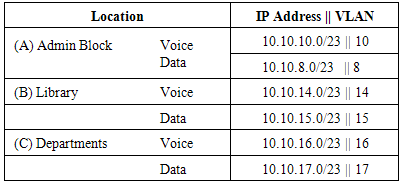 |
| |
|
4. Results and Discussions
4.1. Network Design Specification
The simulation of the VoIP system consisted of four network design model; one for each of the three sites listed in Table 1 and the multiple site central model.i. The Admin Model was designed as a star topology with a central switch through which all other connections are made (Figure 3).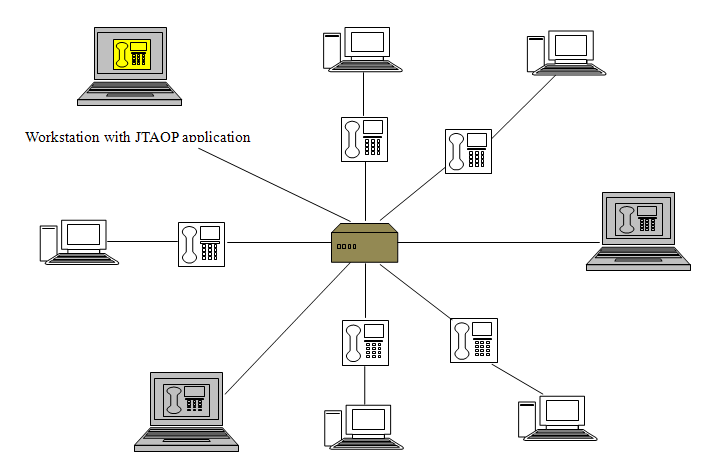 | Figure 3. Star topology of Admin block |
ii. The Library Model was also designed in a star topology but with less computers and IP phones than the administrative block (Figure 4). This is due to the fact that there are less numbers of users in the library site than the administrative block site.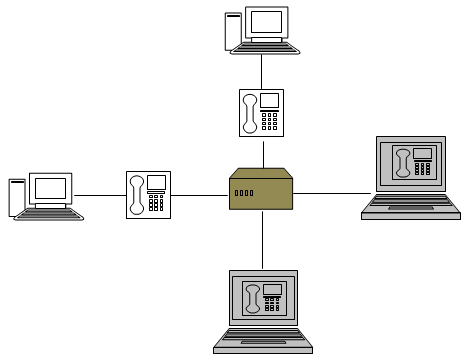 | Figure 4. Network design for the library |
iii. The Department Model: In order to simplify the simulation, the bus topology was chosen for the department because a prototype VoIP system was designed and simulated for one just one department and this can be re-used for other departments (Figure 5). | Figure 5. Network design for a single department |
iv. The Multiple Site Central model comprises of IP phones located at remote sites registered with the call manager cluster located at a central site. The star topology is deployed in this mode as other sites are connected to the central location (Figure 6).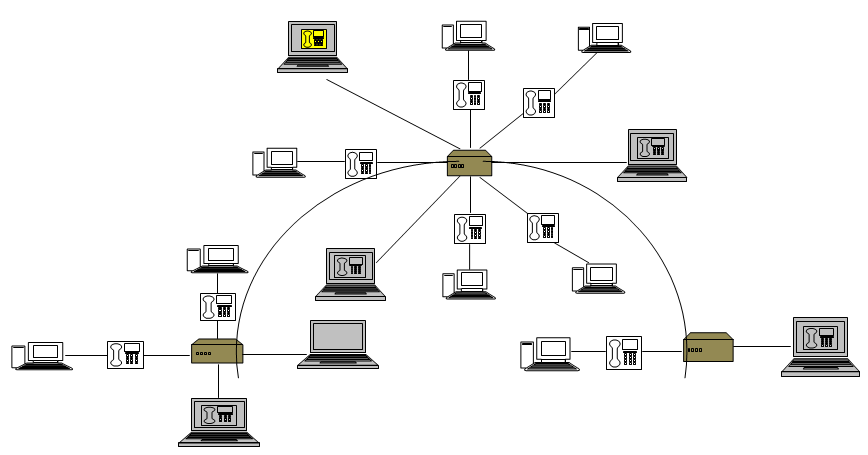 | Figure 6. Multiple Site model with centralized call processing |
4.2. Application Design Specification
The overall IP telephony process is represented below using a flowchart (Figure 7).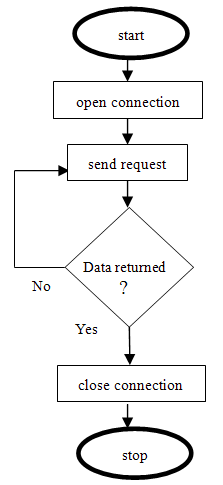 | Figure 7. Flowchart for the VoIP System |
The first activity is the opening of the data connection, followed by sending a call request. A returned data shows the completion of the call and the connection is closed, otherwise, the call request is re-sent until a data connection is returned.Figure 8 gives the state diagram of the IP telephony system. | Figure 8. State Diagram for the Simulation of the Cisco IP Softphone calling process |
4.3. Simulation Results and Sample Experimental Test Scenario Visualization
Sample Simulation Results of the VoIP System from Cisco Packet Tracer and phone connection procedure between two clusters are showed below: A visualization of the Cisco Packet Tracer of the simulation of the three sites in the highest hierarchy is showed in figure 9. The IP addresses for voice and data for the three sites are also specified.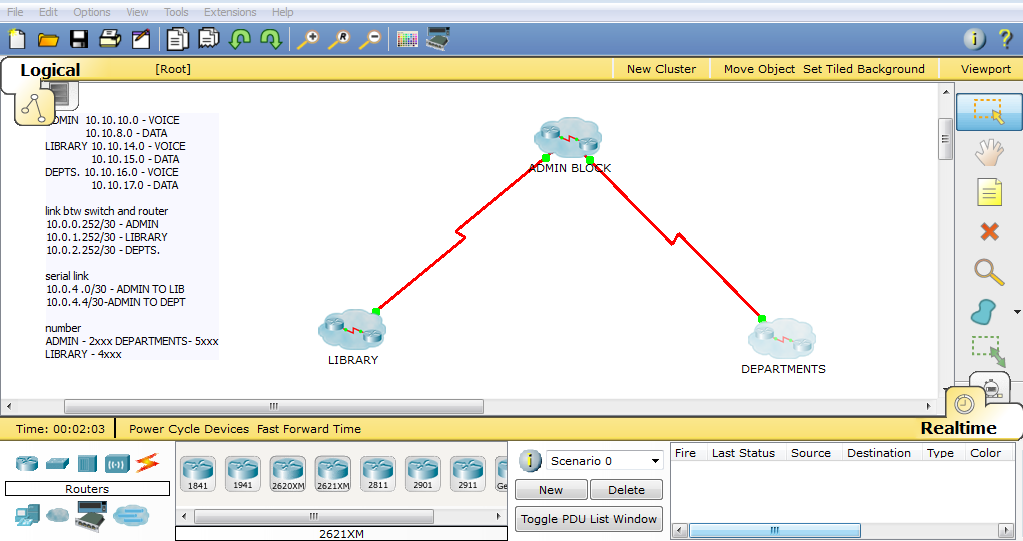 | Figure 9. Diagram showing simulation of clusters in the VoIP system |
The connected cluster of devices are simulated and visualized in figures 10 above. Each hub descends from the main router through a main hub in a hierarchical model. The complete configurations and network parameters for each node can be visualized as depicted in Figure 11. Further simulation of the IP handset is presented in figures 12 and 13.In figure 12, extension 4003 dials extension 5001 which then uses SCCP to contact the CUCM to tell the IP phone what to do. Next, the IP phone contacts the default-gateway to connect it with its destination endpoint (Figure 13).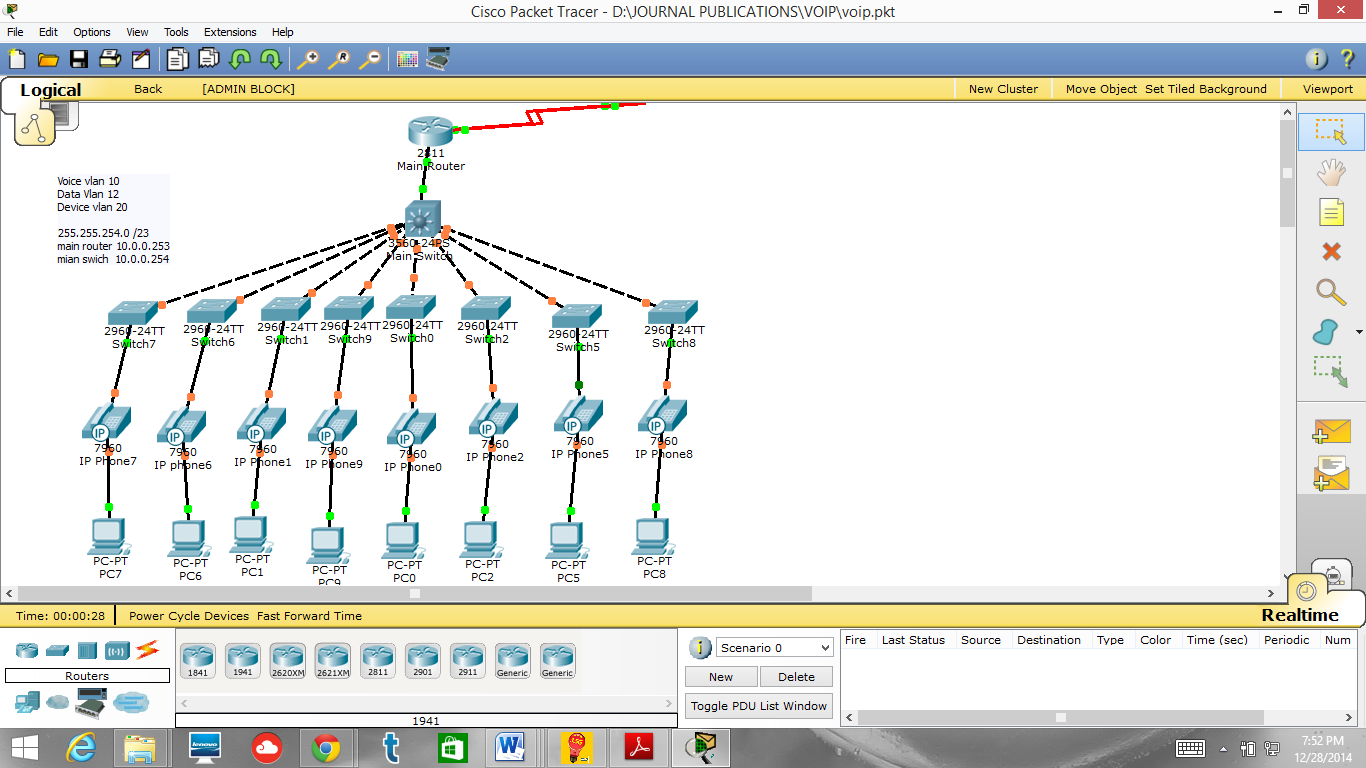 | Figure 10. Connected Devices in the Admin cluster |
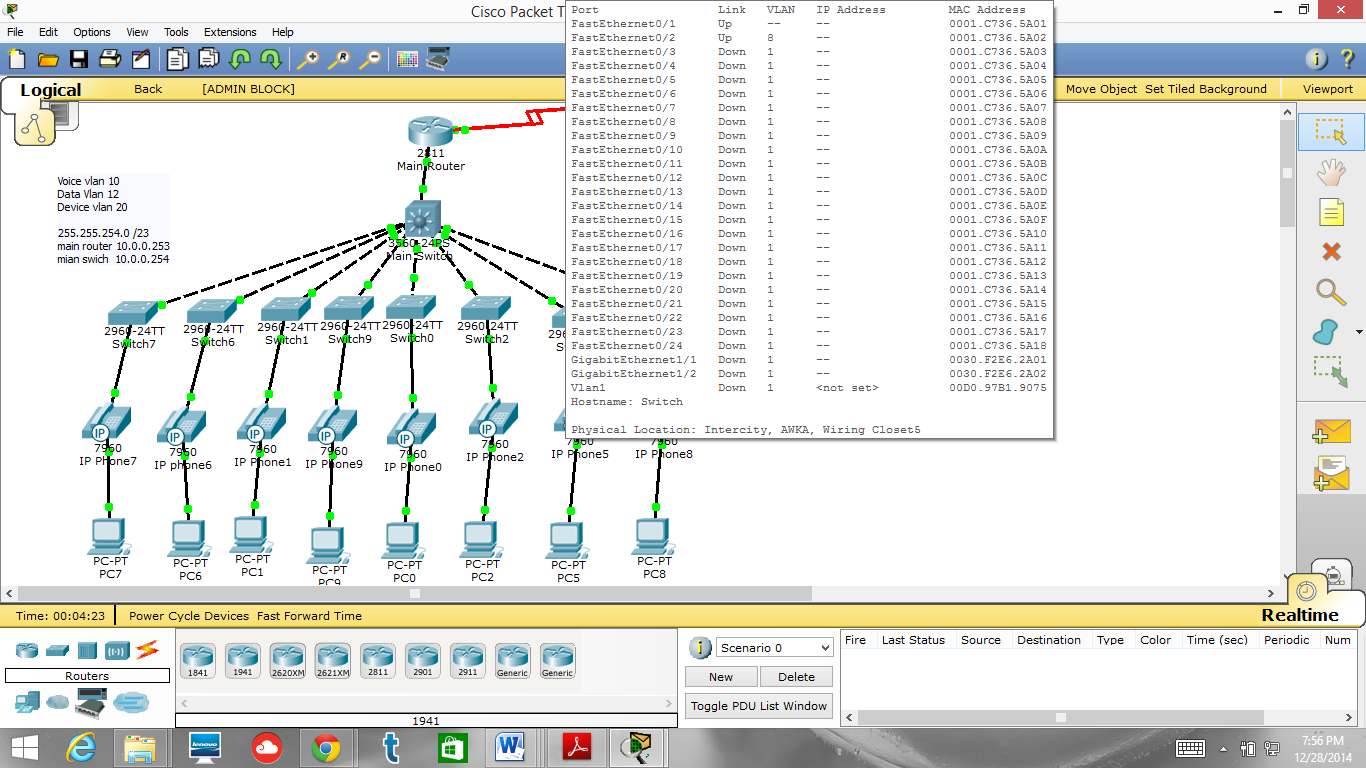 | Figure 11. Configuration settings for the Admin Switch |
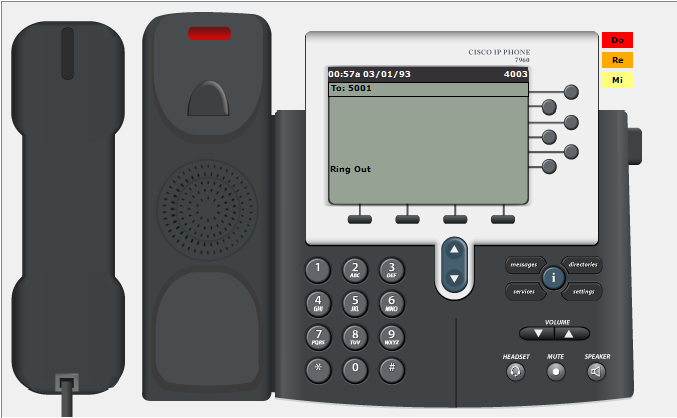 | Figure 12. Extension 4003 dials extension 5001 |
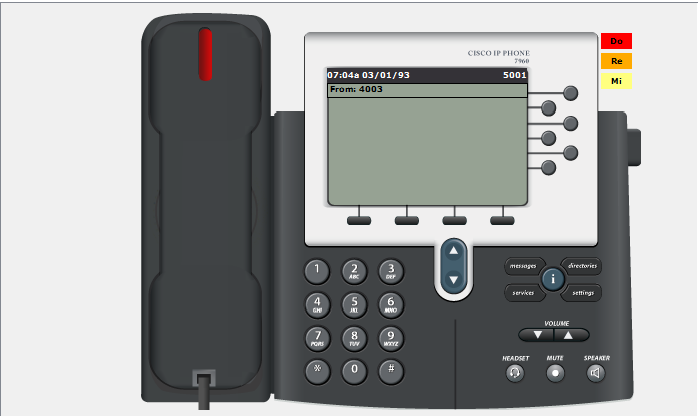 | Figure 13. Destination (Ext 5001) receives call |
5. Conclusions
The researchers in this work had examined the underlining technologies of Voice over Internet Protocols (VoIP) and the possibilities of implementing a campus-wide telephony system using the technology. A prototype design was specified and a simulation was ran using the Cisco Packet Tracer to demonstrate that VoIP can be successfully deployed to provide in a flexible manner, additional data-driven services in campus-wide telephony through a merger of telephone and information technology facilities. While this work had demonstrated the feasibility of leveraging on the affordances of IP-enabled telephones and developing a VOIP-based campus-wide telephony, further research is recommended to test for voice quality and network performance as well as ability for network capacity planning when the system is fully implemented.
References
| [1] | Kumar, A. (2006), An Overview of Voice over Internet Protocol (VoIP). Rivier college online academic journal 2(1). |
| [2] | Pan, Y., Chung, J., Zhang, Z. (2012), Analysis of Performance of VoIP Over various scenarios OPNET 14.0. Group 11 Final Report on ENSC 427 Communication Networks, Simon Fraser University Spring 2012 http://www.sfu.ca/~ypa11/Ensc%20427/427.html. |
| [3] | Kaul, A. (2012), IP Telephony: Review and Implementation. M.Sc. thesis, Department of Electrical Engineering and Computer Science and the Faculty of the Graduate School of the University of Kansas, USA. |
| [4] | Dilekci, D., Wang, C., Feng Xu, J. (2013), The Analysis and Simulation of VoIP Group 3 Final Project Report on ENSC 427 Communication Networks, Simon Fraser University. Spring 2013 http://www.sfu.ca/~cjw11/427Project.html. |
| [5] | Aguiño, G. I., (2007), Performance of VoIP strategies for hybrid Mobile Ad Hoc Networks. Masters thesis, Department of Computer Science, Karlstad University. |
| [6] | Rabassa, A. H. (2010), Simulation Platform for the Planning and Design of Networks Carrying VoIP Traffic Masters of Applied Science in Electrical Engineering Thesis, Faculty of Graduate Studies and Research, Department of Systems and Computer Engineering, Ottawa-Carleton Institute for Electrical and Computer Engineering, Carleton University, Ottawa, Canada. |
| [7] | UV (2014), New University Telephone System: UV's Transition to Voice over Internet Protocol (VoIP). The University of Virginia, http://its.virginia.edu/telephone/home.html. |
| [8] | UT (2014), Project: Voice over Internet Protocol. University of Texas at Austin, http://www.utexas.edu/its/voip/. |














 Abstract
Abstract Reference
Reference Full-Text PDF
Full-Text PDF Full-text HTML
Full-text HTML